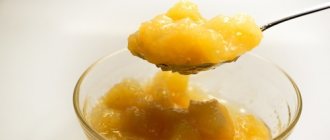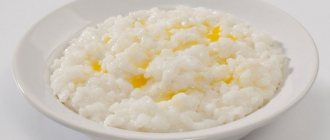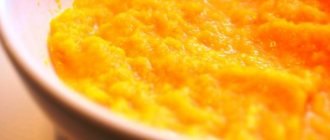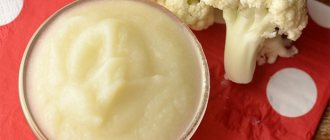We offer simple recipes and useful cooking tips.
Proper and wholesome nutrition is the key to the health and good mood of any child, which is why you need to very carefully choose foods for your baby’s diet. This is especially true for baby purees, since this is the first dish that a child tries after breastfeeding or bottle feeding. The puree should be prepared only from high-quality and fresh products, be hypoallergenic and not contain artificial additives. Now on store shelves there is a wide selection of vegetable, fruit and meat purees for every taste and budget. However, baby purees can be prepared at home using a blender.
There are advantages to making your own baby purees. Firstly, you will be sure that the puree contains only the freshest and healthiest products, especially if these are fruits and vegetables grown in your own summer cottage. Secondly, homemade purees can cost you much less than store-bought ones. So how can you make tasty, healthy and nutritious purees that your baby will love? We offer you several simple and healthy recipes for one- and multi-component vegetable, fruit and meat baby purees.
Why puree?
Puree is an ideal food for feeding infants, and there are several reasons for this:
- Soft food is best absorbed by children's digestion.
- To prevent introducing new food to stress for the baby, you can add a few drops of the usual breast milk or formula to the puree: this way the dish will not lose its taste, and it will not be so foreign to the baby.
- The puree-like consistency allows the baby not to make any serious effort in order to get his portion of food: he practically does not have to chew (and, perhaps, there is nothing else to eat).
- You can simply prepare the dish yourself or buy a ready-made product: the quality of modern baby food from well-known brands is beyond doubt.
- If you decide to make baby puree at home with your own hands, you can make it for future use. This luxury of saving time and effort is not available with all types of children's dishes, because most of them need to be eaten only freshly prepared.
How to prepare vegetable puree for first feeding
First of all, we remember that for the first complementary feeding, parents must choose one vegetable, let it be cauliflower. Only after 7-10 days have passed and the baby is already eating a significant portion of puree, about 50-100 grams, can you introduce another one into the menu.
Since vegetables are always, as a rule, dirty, you should definitely rinse cauliflower thoroughly in running water and dry it, for example, by wiping it with kitchen paper towels.
Now you need to disassemble the cabbage into small inflorescences and place them in a bowl with a strong saline solution. This will help get rid of parasites inside the inflorescences and also additionally wash away dirt.
ADVICE! With this exception, and except for pre-peeled potatoes, you should not soak vegetables before cooking so as not to lose important vitamins.
First food: vegetable puree. Chopped and washed vegetables are poured with clean water and set to boil or steamed. In this case, vitamins and taste are not “washed out” from the product; the maximum amount of vitamins and minerals is retained in the puree.
It is necessary to puree vegetables while hot, immediately after cooking; when they have cooled down, it will not be easy to do this in order to achieve a uniform consistency, especially if you don’t have a blender and only have a sieve on hand. But you can crush vegetables with a puree masher or a fork when the baby learns to chew confidently.
First feeding: how to prepare vegetable puree (video)
When the time comes
In the first six months to a year of life, a baby can easily receive all the necessary substances from breast milk, and the inclusion of other products will be more of an addition than a replacement.
If grandmothers used to introduce a child to new tastes at the age of 3 months, today pediatricians strongly recommend starting the first complementary foods no earlier than six months.
Until reaching this age, the baby does not need any other food except his favorite sweet milk. As a rule, his immature digestion is not ready for gastronomic experiments. Another argument against early complementary feeding is that the sooner you offer your baby a new product, the more likely he is to react to it with an allergy.
For babies fed with artificial formula, the timing for the first complementary feeding is usually earlier.
Probably every mother wonders at what age it is possible to give her baby new food, and almost always doubts whether her child is really ripe for such a “revolution” in his diet. Often worries are in vain: the baby himself will begin to hint to her that he is ready for innovations. You will understand his signs by the following signs:
- the baby will begin to observe with interest what and how you eat;
- will ask for food more often;
- will try to eat on his own;
- if you give him something to try, he won't protest.
But when it is possible to give a child this or that food for complementary feeding is an individual question for each new item on the baby’s menu. Types of foods are differently suited to children's digestion and are characterized by varying degrees of allergenicity.
Fortunately, basic rules from pediatricians still exist and have been successfully tested through personal experience by many mothers.
Rules for introducing complementary foods
When to give:
- baby age – 4 – 6 months;
- manifestation of food interest;
- the baby is able to eat in an upright position;
- the child's well-being;
- complementary foods cannot be introduced 3 days before and 3 days after vaccination;
- a new product is given for the first time in a volume of no more than one teaspoon;
- every day the quantity increases to the required volume;
- a period of 5-7 days is allotted for the introduction of any product;
- Any unfamiliar dish should be tried in the first half of the day.
Before introducing new products, you need to consult a pediatrician about the age at which you can give your child a new dish. It is up to the observing specialist to decide when to give the first complementary foods. He will also recommend how to introduce complementary foods.
The ideal option for the first acquaintance is undoubtedly vegetable puree for infants. They contain a lot of useful substances necessary for an actively developing organism. The fiber contained in purees for infants will help improve the baby's bowel movements.
A young mother may well choose ready-made treats, which are available in abundance in children's stores. All that remains is to decide which jars from which company to choose. Any brand provides a very wide selection of finished products. Each mother determines her own rating of baby purees. Many parents do not trust ready-made baby food and prefer to prepare baby puree themselves.
Memo for mom
Making puree for babies is quite simple. This dish usually quickly becomes a child's favorite. And if you decide that the time has come for your child to eat “adult” food, remember some important rules:
- The ideal option for complementary feeding at the age of 6 months is a one-component vegetable puree, consisting of one ingredient. A little later, when the baby’s menu includes 1 introduced vegetable or more, you can mix the acquired ingredients and prepare a monocomponent puree.
- It is recommended to start getting acquainted with new products in the form of purees according to the following scheme: the baby is first offered a teaspoon of the treat, then gradually, by slowly increasing the portion, the dosage is increased to 50 grams.
- The first step on the path to adult food often causes bewilderment in the baby, and more often - whims and protests. In this case, the mother needs to be patient and not give up her attempts to introduce the stubborn little one to new food. Offer one type of food at least 10 times, and if the reaction to the product is equally negative, try using another vegetable to make puree for the baby.
- No matter how bland and tasteless baby puree for complementary feeding may taste to you, it is forbidden to dilute it with salt, oil and spices. Your child is not yet familiar with other tastes, so the product will seem very edible and incomparable to anything, in the literal sense.
- Even if you tried baby puree and wanted to spit it out, the baby should not suspect this. Here you need the opposite approach: share a new dish with your baby and eat it with great pleasure: this way you will arouse his curiosity about the product.
It is better to offer puree prepared on your own to the baby immediately after cooling: the benefits and taste of a fresh dish are always higher.
Fruit and vegetable baby purees
After the first feeding with single-component purees and, more importantly, in the absence of allergic reactions in the child to specific foods, you can try giving the baby purees consisting of several components. As a rule, such purees are more nutritious and children like them more. Multicomponent purees can be only vegetable or only fruit, or they can be mixed. Such dishes allow the baby to get the maximum of vitamins and nutrients contained in the products. The ideal option for complementary feeding with multi-component purees is green fruits and vegetables that do not cause allergies. That is why parents very often prepare fruit and vegetable puree from zucchini and apples.
Preparing baby puree from zucchini and apples
Zucchini is the least allergenic among vegetables and fruits. At the same time, it has a lot of minerals and fiber, it is rich in potassium, which ensures good heart function, and contains vitamins A and C. In addition, zucchini has a delicate consistency - this is an additional plus. The apple, in turn, is rich in vitamins A, B, B2, B6 and minerals: magnesium, iron, phosphorus, iodine - and this is not a complete list. Apple also provides natural protection for the body against viruses.
Wash apples and zucchini before making puree. Then peel them, remove the seeds and cut into small pieces. Zucchini and apples for puree need to be boiled separately, since each of them has different cooking times: apples in a pan are cooked for 20-25 minutes, zucchini - 15-20 minutes. It is preferable to steam the ingredients, this way you will retain more vitamins and save time. In a double boiler, apples need 15 minutes, zucchini - 10. After cooking, both components need to be rubbed through a sieve or chopped with a blender. Next, mix the mixtures and bring to a boil. The puree needs to be cooled to 30-40 degrees. By the way, this recipe is ideal for a child with allergies.
We carefully select ingredients
In such an important issue as the introduction of complementary feeding to a baby, it is useful for every mother to know which products are optimal for the child’s body at the age of about 6 months.
The first dish for a baby is usually vegetable purees and sometimes porridge. Today we are talking about puree. The main criteria when choosing a product for its preparation are hypoallergenicity, benefits, safety and ease of absorption by children's digestion.
Universal components for complementary feeding include zucchini and broccoli: it is from them that most parents prepare the first puree in their baby’s life. When he has mastered these simple vegetables, it will be the turn of pumpkin, potatoes, green peas, carrots, spinach and kohlrabi.
But the question arises: which puree is better, homemade or store-bought?
When to start giving vegetable puree to your baby?
First food: vegetable puree. First of all, parents need to understand that they need to introduce vegetables into their baby’s diet from one product, for example, cauliflower or zucchini. After 2-3 types of vegetables have already been tested by the baby, they can be mixed during cooking, in the required proportions.
How to organize a child’s nutrition in the first year of life and beyond, read our article HERE
Broccoli, zucchini and cauliflower are vegetables for first feeding, they are hypoallergenic and as safe as possible for the child. In addition, this type of vegetable contains many vitamins and minerals.
If vegetables are introduced at 4-4.5 months, then parents are advised to give the owl preference for jarred puree; it is very tender and homogenized, that is, very finely pureed. The jar is just enough for 2 complementary foods, which is very convenient for both mother and baby.
After 5 - 6 months, the assortment can be expanded a little and add white cabbage, pumpkin or carrots. At 7 months, mashed potatoes can be introduced little by little.
By 8 months of age, your baby can try green peas and beans. Other vegetables can also be gradually included in the diet, for example, beets, which are difficult to digest.
After a year, you can offer your child to try tomatoes, sweet peppers and eggplants, but only if complementary feeding occurs in the summer months. Winter fruits with nitrates will not bring any benefit to the baby.
From mom with love
Many mothers with the best intentions prefer to prepare baby puree at home in order to provide the baby with the most natural food. This solution has both pros and cons.
Advantages
- you cannot be deceived in the naturalness of the process: after all, you do everything yourself;
- in this case, the mother is the main expert on storage conditions and compliance with expiration dates;
- baby purees prepared at home are always the freshest and healthiest;
- guaranteed absence of preservatives, dyes and other harmful additives;
- You can prepare the treat “in bulk” and store it in the freezer;
- confidence in sanitary cooking conditions;
- saving money, because it’s easier to buy the necessary products for future use rather than spending money on a jar of puree every time;
- you determine the portion yourself and, depending on it, select the right amount of ingredients;
Flaws
Making puree at home also has its disadvantages:
- the complexity of the process is familiar to every mother of a baby who has chosen homemade complementary foods;
- making puree yourself takes a long time, and this time could be spent on more enjoyable activities: for example, playing with the baby;
- the quality of purchased vegetables and fruits is often questionable, especially if you purchase them out of season;
- The shelf life of a fresh product is limited to a day in the refrigerator, and even this is undesirable;
- homemade purees are more difficult to take with you;
- It is problematic to prepare small portions: especially in a blender, when the minimum amount has to be literally scraped off the walls.
Rules for processing and preparing products
Remember that not every combination of vegetables and fruits tastes good, and babies may be allergic to one or another product, so carefully monitor your baby’s reaction! Also, regardless of what vegetables, fruits or meat you prepare puree from, it is important to follow a few simple rules for processing and preparing products.
- Rinse fruits and vegetables thoroughly both before and after cleaning: this way you will remove the maximum amount of contaminants.
- If possible, use a steamer rather than a stovetop to steam vegetables and fruits. This way the vegetables will retain their color, taste and most of the vitamins and minerals.
- If you use a stove, then cook vegetables and fruits in enamel dishes - it does not release substances harmful to the child.
- Do not overcook vegetables and fruits - this will cause them to lose their taste and beneficial properties.
- When making purees, use filtered water.
- When preparing mashed potatoes for babies, soak vegetables and fruits in water, especially if they were purchased at the store (potatoes - 12-24 hours, other vegetables - 1-2 hours). This will remove nitrates, pesticides and other harmful substances.
- Always use fresh meat for meat puree. It should be frozen no more than once.
- Use dietary, lean meat - turkey, chicken, veal - so as not to put a strain on your baby’s digestive system.
It's up to you to decide which is better: store-bought baby purees or homemade ones. Homemade purees are convenient because they can be prepared taking into account your child’s taste preferences, and besides, you don’t have to pay for a jar. In addition, by preparing puree at home, you can be sure of the quality and freshness of the products. However, mothers do not always have enough free time to prepare baby purees with their own hands, so ready-made purees may be a good alternative. Moreover, modern purees sold in stores, as a rule, have the necessary sets of vitamins and minerals, and they are also hypoallergenic.
Product-test.ru experts, together with specialists from the Russian Academy of Medical Sciences, tested baby food in leading Russian laboratories and in numerous test groups consisting of mothers. On our website you can familiarize yourself with the test results of popular vegetable and fruit purees, dry baby formulas and baby juices.
Want to understand other important issues? Read a selection of useful articles from experts.
Feeding from a jar
Often, due to lack of time or the presence of any convictions, parents of infants decide that making purees at home is not practical. Then store-bought products come to their aid.
Advantages
Puree bought in a store is often also a good option, because it has significant advantages:
- its quality is subject to strict government control;
- Manufacturers have thought through everything for convenience: sealed packaging and long shelf life;
- the main advantage for many women is that they do not have to waste time on cooking;
- the food is completely ready to eat;
- Manufacturers take into account the characteristics of the baby’s age and make the product in accordance with them;
- In many purees, several ingredients are mixed at once: for example, vegetables and cereals;
- often children's products contain additional vitamins;
- You can read the entire composition on the jar to be sure of your purchase.
Flaws
Unfortunately, store-bought purees for babies also have some disadvantages:
- the nutritional value of store-bought treats is often lower compared to home-prepared treats due to the high water content;
- the taste is sometimes less intense;
- sometimes quality control is not the strictest and you can lose sight of the freshness of the ingredients and the correctness of the cooking technology;
- the high price for one jar is also not encouraging;
- Many store-bought purees contain unwanted salt and sugar.
Parental control
To make buying baby puree for complementary feeding a joy, you should know what to look for in the store.
How to choose
In fact, everything is very simple and, taking these points into account, any mother will choose the best quality product:
- Evaluate the tightness of the packaging: the lid should be tightly closed, and the entire jar should be wrapped in film.
- Don't forget to check the expiration date.
- The composition deserves special attention: there should be no unnecessary components.
- The color of the puree should be the same as that of the main product in the composition.
Rating of the best manufacturing companies
Many mothers of infants are interested in which brand of baby purees for complementary feeding is the best. Parents make their ratings empirically and then share their observations. Among the most popular and high-quality ones are:
- "Gerber";
- “Grandma’s Basket”;
- "FrutoNyanya";
- "Subject";
- "Agusha";
- "Hipp";
- "Semper";
- "Humana";
- "Haines"
- "Nutrition".
Easy preparation
Don't know how to make baby puree at home? Basic recipes for a delicious children's dish will help you navigate the technology:
- The first puree for a baby is often made from zucchini. How to do? Very simple! Cook several rings of peeled vegetables for 10 minutes in a double boiler. Then grind the vegetable in a blender and rub through a sieve: the dish is ready.
- Making broccoli puree is just as easy. Boil the washed inflorescences in a double boiler for 20 minutes. In a saucepan, frozen broccoli will cook for 15 minutes after boiling, while fresh broccoli will take only 5-7 minutes. Please note that the water should only slightly cover the vegetable. After this, puree the broccoli using a blender or strainer.
https://youtu.be/bzojmUS019g
Zucchini puree
The rating of the very first dish is topped by zucchini puree. When choosing vegetables for your baby, it is advisable to choose small fruits. Such zucchini contains more useful substances than mature ones. To prepare you will need a blender. Such a device will allow you to achieve an absolutely homogeneous consistency.
How to do:
- To prepare, you need to take 1 zucchini, wash and peel. If the seeds are large, it is necessary to remove the core.
- Cut into cubes. Place the prepared zucchini in an enamel saucepan and add a small amount of water.
- Cook until soft, drain. Grind the finished vegetable in a blender, add a teaspoon of oil.
You can also steam the zucchini or microwave it.











